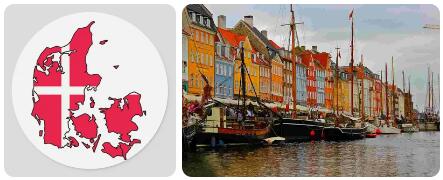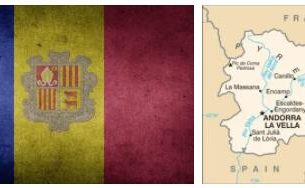Denmark – land of the little mermaid
Today’s Denmark is the land of the “little mermaid”, Lego bricks and the land of Hamlets.
Denmark is a liberal country with an absolutely stable parliamentary democracy. The head of state is a king or a queen. The head of government is a prime minister elected by parliament.
Denmark consists of over 400 islands, many of which are uninhabited due to their size and invite you to visit. Due to its geography, its climate and its people, the country is extremely suitable as a holiday destination, be it in a holiday bus, a guesthouse, a hotel, by (sailing) boat, caravan, as a hiker in a tent or by bike. It is particularly suitable for families with (small) children. The country covers an area (excluding Greenland) of around 43,000 km2 with around 5.48 million residents. The capital is Copenhagen with around 1.83 million residents.
The national language is Danish. In Jutland, however, German is also spoken and in Greenland and the Faroe Islands a separate language is spoken.
Despite Denmark’s EU membership, the currency is not the euro, but the Danish krone. It should be noted that Denmark has a relatively high price level, but you can still vacation there relatively cheaply with your own initiative and a little imagination.
In 1989, Denmark was the first country in the world to establish a civil union between same-sex couples (registered partnership). On June 7, 2012, with a majority of 85 against 24, parliament voted for a law that made marriage possible for same-sex couples and also legalized church weddings.
| Name in Danish | Kongeriget Danmark (Kingdom of Denmark) |
| Form of government | parliamentary democracy with a king as head of state |
| Geographical location | The country is located north and northeast of Germany in Scandinavia |
| National anthem | Denmark has two national anthems, a civil one: “Der er et yndigt land” and a royal one: “Kong Christian stod ved højen mast” |
| Head of state | Queen Margrethe II (since January 15, 1972) |
| Population | 5.6 million (Credit: Countryaah: Denmark Population) |
| Ethnicities | Around 95% are Danes, 1.5% Asians and, surprisingly, only 0.5% Scandinavians. The rest is spread over a wide variety of nations or ethnic groups. |
| Religions | approx. 83% Evangelical Lutheran, 2% other Christian churches,4% Muslim, around 10% without church membership |
| Languages | Danish as the official language |
| Capital | Copenhagen with approx. 550,000 residents |
| Surface | without Greenland: 43,094 km²with Greenland: 2,218,694 km² |
| Highest elevation | Yding Skorhøj, 171 m |
| Longest river | Gudena, 160 km |
| Largest lake | Arresee with an area of about 41 km² |
| International license plate | DK |
| National currency | Danish crown = 100 Øre |
| Time difference to CET | = CET |
| International phone code | +45 |
| Mains voltage, frequency | 230 volts, 50 hertz |
| Internet Top Level Domain (TLD) | .dk |
Denmark: history
Before the year 1000
The oldest traces of human settlement in Denmark can be traced back to the end of the last Ice Age around 12,500 BC. lead back. Agriculture and permanent settlements formed in the New Stone Age (3,900 BC). The first cities emerged from AD 400-750. The consolidation of the first central power began at the same time as the decline of the Merovingian empire around 700 under a king named Angantyr and was completed under Harald I (910-987), who is known as “The Blue Tooth”. The founding of this kingdom was recorded in writing in the rune stone of Jelling in Jutland at the end of the ninth century. The word Denmark was mentioned in writing for the first time here.
The Vikings
According to Abbreviationfinder website, around 800 the Vikings, who soon became known and feared in Europe, began their expeditions of conquest and discovery. As a result, Danish kings were able to establish their power in England, Ireland, France and even Russia. In France, Viking chiefs received fiefs from Frankish princes. Normandy was the best known of these fiefdoms.
From the year 1000 to the 17th century
Denmark is the oldest existing kingdom in Europe in this form. The oldest known Viking king is probably Godfred, who ruled until around 810.
From 950 there is a continuous king succession in Denmark. Knud IV the Great established a high point of Danish power. (Reign: 1080-1086) with the conquest of all of England. In north and east England many place names still refer to the earlier conquerors. Knud became king of Norway and parts of Sweden.
From 1380 to 1814 Denmark was united in the personal union with Norway, from 1389 to 1523 also with Sweden in the so-called Kalmar Union. In the centuries from 1660 to 1848 Denmark ruled an absolutist monarchy. In the Treaty of Copenhagen in 1660, Denmark ceded the southern Swedish possessions east of the Sound and suffered defeat in the struggle for supremacy in the Baltic Sea.
In the 18th and 19th centuries
Due to its geographical location, Denmark played an important political and economic role in the Baltic Sea region in the 18th century. At the beginning of the Napoleonic Wars, Denmark was neutral. In 1801 and 1807 the English navy attacked Copenhagen. Denmark then merged with France.
The English robbed the Danish war and merchant fleets in 1814/15. After the alliance with Napoleon, Denmark had to cede Norway to Sweden and Heligoland to England after seven years of war at the peace negotiations, the Congress of Vienna and the Kiel Peace Treaty. Denmark received the Duchy of Lauenburg and parts of Schleswig Holstein.
In 1849 Denmark got a new constitution and with it the introduction of a constitutional monarchy. In the years 1863 and 1864 the Schleswig Wars took place and caused the loss of the duchies of Schleswig and Holstein, which were linked in personal union. That was almost a third of the area and the population.
In the 20th century
In 1915 the democratic constitution and thus the right to vote for women was introduced. The West Indian Virgin Islands were sold to the United States in 1917 after negotiations. In 1918 the real union with Iceland was ended, in 1944 the personal union ended.
Denmark remained neutral during the First World War, but won back most of Schleswig through a referendum on the basis of the Versailles Treaty. Denmark was occupied by German troops during World War II. Wilhelm Buhl became the first Prime Minister after the German occupation in 1945. Denmark is a founding member of the United Nations Organization from 1945.
In 1949 it joined NATO, in 1950 it joined the Council of Europe. In 1953 there was a constitutional amendment to introduce female succession and the abolition of the Landsting, the 2nd Parliamentary Chamber.
Denmark joined the EC in 1973 (excluding the Faroe Islands; Greenland left the EC in 1982).
In 1979 Greenland became self-governing.
Denmark is a founding member of the 1992 Baltic Sea Council, but rejected the Maastricht Treaty in a referendum. In 1993, the Maastricht Treaty was approved with the four Edinburgh reservations (internal and external security, euro, citizenship).
In 1998, Denmark, together with the Secretary General of the United Nations, took the initiative to create a permanent United Nations Emergency Brigade based in Copenhagen (SHIRBRIG). In 2000 the introduction of the euro was rejected in a referendum.
In 2002, the decision to expand the EU to the east was answered positively at the European Council in Copenhagen under the Danish EU Council Presidency. Denmark showed military engagement on the side of the USA in the Iraq war in 2003 and participated in the reconstruction of Iraq.
Crown Prince Frederik and Crown Princess Mary married on May 13, 2004.



